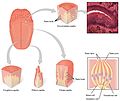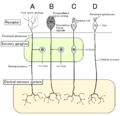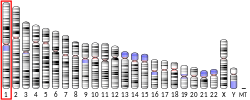A taste receptor or tastant is a type of cellular receptor that facilitates the sensation of taste. When food or other substances enter the mouth, molecules...
42 KB (4,345 words) - 16:41, 19 June 2024
Umami (redirect from Umami taste)
one of the five basic tastes. It is characteristic of broths and cooked meats.: 35–36 People taste umami through taste receptors that typically respond...
32 KB (3,463 words) - 15:53, 23 August 2024
mouth reacts chemically with taste receptor cells located on taste buds in the oral cavity, mostly on the tongue. Taste, along with the sense of smell...
94 KB (10,378 words) - 10:04, 30 August 2024
Taste buds are clusters of taste receptor cells, which are also known as gustatory cells. The taste receptors are located around the small structures...
7 KB (836 words) - 03:51, 1 July 2024
Sweetness (redirect from Sweet taste)
the taste bud that each express a receptor for the perception of sweet, sour, salty, bitter or umami. Downstream of the taste receptor, the taste cells...
34 KB (3,882 words) - 07:51, 2 August 2024
Sensory neuron (redirect from Phasic receptor)
Exteroreceptors include chemoreceptors such as olfactory receptors (smell) and taste receptors, photoreceptors (vision), thermoreceptors (temperature)...
29 KB (3,290 words) - 07:35, 2 August 2024
Aftertaste (section Taste receptor dynamics)
spat out. The neurobiological mechanisms of taste (and aftertaste) signal transduction from the taste receptors in the mouth to the brain have not yet been...
17 KB (2,361 words) - 22:01, 26 February 2024
TAS2R38 (category Human taste receptors)
Taste receptor 2 member 38 is a protein that in humans is encoded by the TAS2R38 gene. TAS2R38 is a bitter taste receptor; varying genotypes of TAS2R38...
21 KB (2,405 words) - 04:27, 31 August 2024
Dysgeusia (redirect from Metallic food taste)
component of the taste mechanism. Saliva both interacts with and protects the taste receptors in the mouth. Saliva mediates sour and sweet tastes through bicarbonate...
43 KB (5,315 words) - 11:53, 12 August 2024
protein-coupled receptor that functions as a taste receptor, mediated by ligands such as PROP and phenylthiocarbamide that bind to the receptor and initiate...
30 KB (2,624 words) - 01:26, 14 August 2024
The evolution of bitter taste receptors has been one of the most dynamic evolutionary adaptations to arise in multiple species. This phenomenon has been...
12 KB (1,578 words) - 22:51, 30 April 2024
TAS1R2 (category Human taste receptors)
T1R2 - Taste receptor type 1 member 2 is a protein that in humans is encoded by the TAS1R2 gene. The sweet taste receptor is predominantly formed as a...
13 KB (1,637 words) - 17:37, 25 August 2024
additives. The company claimed to have "reverse engineered" human taste and aroma receptors. It was founded by Lubert Stryer and Paul Nevsky in 1998. On 17...
5 KB (432 words) - 07:06, 7 December 2023
Coriander (section Taste and smell)
others find pleasant. Association between its taste and several other genes, including a bitter-taste receptor, have also been found. Some people are allergic...
27 KB (3,041 words) - 20:51, 24 August 2024
Gustducin (section Evolution of bitter taste receptors)
Gustducin is a G protein associated with taste and the gustatory system, found in some taste receptor cells. Research on the discovery and isolation of...
18 KB (2,244 words) - 17:20, 31 March 2024
TAS1R1 (category Human taste receptors)
Taste receptor type 1 member 1 is a protein that in humans is encoded by the TAS1R1 gene. The protein encoded by the TAS1R1 gene is a G protein-coupled...
10 KB (1,285 words) - 02:24, 29 November 2023
Cruciferous vegetables (section Taste)
2004). "Natural selection and molecular evolution in PTC, a bitter-taste receptor gene". American Journal of Human Genetics. 74 (4): 637–46. doi:10.1086/383092...
13 KB (1,031 words) - 02:36, 19 April 2024
bioactive constituents that interact with taste receptors on the tongue to temporarily suppress the taste of sweetness. The plant is a climber with leaves...
14 KB (1,468 words) - 07:42, 23 March 2024
Sense (section Gustatory system (taste))
gustatory (taste) and olfactory (smell) sensations. Within the structure of the lingual papillae are taste buds that contain specialized gustatory receptor cells...
90 KB (10,689 words) - 09:43, 4 May 2024
Special senses (section Taste)
ten minutes. Taste is the sensation produced when a substance in the mouth reacts chemically with taste receptor cells located on taste buds in the oral...
16 KB (1,924 words) - 18:15, 18 February 2024
quickly generated but shorter-lasting receptor potential. An example of a receptor potential is in a taste bud, where taste is converted into an electrical...
3 KB (366 words) - 05:24, 4 April 2023
Glutamate flavoring (section Taste perception)
specific receptors located in taste buds such as the amino acid receptor T1R1/T1R3 or other glutamate receptors like the metabotropic receptors (mGluR4...
35 KB (3,771 words) - 06:02, 13 July 2024
TAS1R3 (category Human taste receptors)
Taste receptor type 1 member 3 is a protein that in humans is encoded by the TAS1R3 gene. The TAS1R3 gene encodes the human homolog of mouse Sac taste...
12 KB (1,547 words) - 17:34, 25 August 2024
bitter receptors, amplifying the taste of other sweet, bitter and umami tastants. The synergetic effect of the glycosides on the sweet receptor and TRPM5...
44 KB (4,156 words) - 20:43, 29 July 2024
Chemoreceptor (redirect from Chemical receptor)
a nerve fiber if the chemoreceptor is a specialized cell, such as taste receptors, or an internal peripheral chemoreceptor, such as the carotid bodies...
20 KB (2,600 words) - 04:41, 27 May 2024
Gustatory cortex (section Role in the taste pathway)
the intensity of the taste stimulus. Like the olfactory system, the taste system is defined by its specialized peripheral receptors and central pathways...
18 KB (2,264 words) - 13:16, 5 March 2024
Phenylthiocarbamide (section Role in taste)
between PTC tasting and dietary differences. Much of the variation in tasting of PTC is associated with polymorphism at the TAS2R38 taste receptor gene. In...
17 KB (1,680 words) - 03:20, 12 August 2024

















